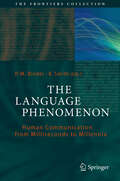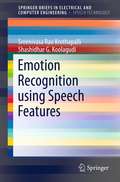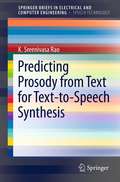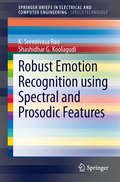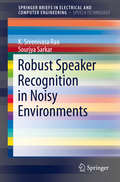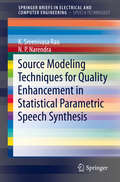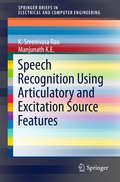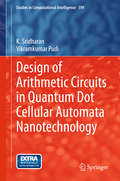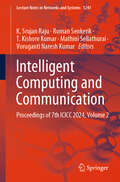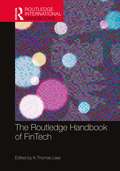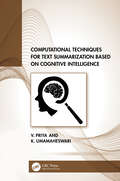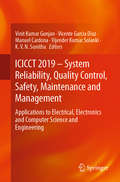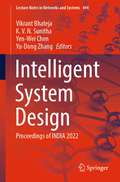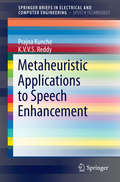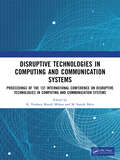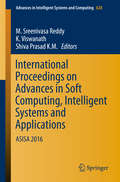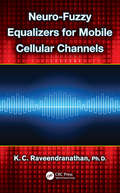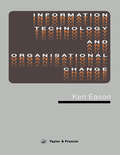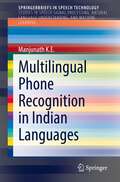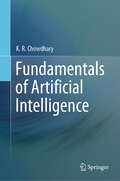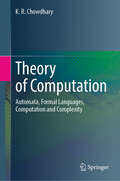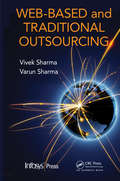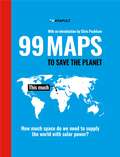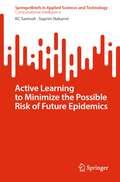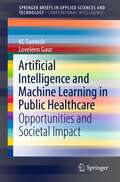- Table View
- List View
The Language Phenomenon
by K. Smith P. M. BinderThis volume contains a contemporary, integrated description of the processes of language. These range from fast scales (fractions of a second) to slow ones (over a million years). The contributors, all experts in their fields, address language in the brain, production of sentences and dialogues, language learning, transmission and evolutionary processes that happen over centuries or millenia, the relation between language and genes, the origins of language, self-organization, and language competition and death. The book as a whole will help to show how processes at different scales affect each other, thus presenting language as a dynamic, complex and profoundly human phenomenon.
Emotion Recognition using Speech Features
by K. Sreenivasa Rao Shashidhar G. Koolagudi"Emotion Recognition Using Speech Features" provides coverage of emotion-specific features present in speech. The author also discusses suitable models for capturing emotion-specific information for distinguishing different emotions. The content of this book is important for designing and developing natural and sophisticated speech systems. In this Brief, Drs. Rao and Koolagudi lead a discussion of how emotion-specific information is embedded in speech and how to acquire emotion-specific knowledge using appropriate statistical models. Additionally, the authors provide information about exploiting multiple evidences derived from various features and models. The acquired emotion-specific knowledge is useful for synthesizing emotions. Features includes discussion of: * Global and local prosodic features at syllable, word and phrase levels, helpful for capturing emotion-discriminative information; * Exploiting complementary evidences obtained from excitation sources, vocal tract systems and prosodic features in order to enhance the emotion recognition performance; * Proposed multi-stage and hybrid models for improving the emotion recognition performance. This brief is for researchers working in areas related to speech-based products such as mobile phone manufacturing companies, automobile companies, and entertainment products as well as researchers involved in basic and applied speech processing research.
Predicting Prosody from Text for Text-to-Speech Synthesis
by K. Sreenivasa RaoPredicting Prosody from Text for Text-to-Speech Synthesis covers the specific aspects of prosody, mainly focusing on how to predict the prosodic information from linguistic text, and then how to exploit the predicted prosodic knowledge for various speech applications. Author K. Sreenivasa Rao discusses proposed methods along with state-of-the-art techniques for the acquisition and incorporation of prosodic knowledge for developing speech systems. Positional, contextual and phonological features are proposed for representing the linguistic and production constraints of the sound units present in the text. This book is intended for graduate students and researchers working in the area of speech processing.
Robust Emotion Recognition using Spectral and Prosodic Features
by K. Sreenivasa Rao Shashidhar G. KoolagudiIn this brief, the authors discuss recently explored spectral (sub-segmental and pitch synchronous) and prosodic (global and local features at word and syllable levels in different parts of the utterance) features for discerning emotions in a robust manner. The authors also delve into the complementary evidences obtained from excitation source, vocal tract system and prosodic features for the purpose of enhancing emotion recognition performance. Features based on speaking rate characteristics are explored with the help of multi-stage and hybrid models for further improving emotion recognition performance. Proposed spectral and prosodic features are evaluated on real life emotional speech corpus.
Robust Speaker Recognition in Noisy Environments
by K. Sreenivasa Rao Sourjya SarkarThis book discusses speaker recognition methods to deal with realistic variable noisy environments. The text covers authentication systems for; robust noisy background environments, functions in real time and incorporated in mobile devices. The book focuses on different approaches to enhance the accuracy of speaker recognition in presence of varying background environments. The authors examine: (a) Feature compensation using multiple background models, (b) Feature mapping using data-driven stochastic models, (c) Design of super vector- based GMM-SVM framework for robust speaker recognition, (d) Total variability modeling (i-vectors) in a discriminative framework and (e) Boosting method to fuse evidences from multiple SVM models.
Source Modeling Techniques for Quality Enhancement in Statistical Parametric Speech Synthesis (SpringerBriefs in Speech Technology)
by K. Sreenivasa Rao N. P. NarendraThis book presents a statistical parametric speech synthesis (SPSS) framework for developing a speech synthesis system where the desired speech is generated from the parameters of vocal tract and excitation source. Throughout the book, the authors discuss novel source modeling techniques to enhance the naturalness and overall intelligibility of the SPSS system. This book provides several important methods and models for generating the excitation source parameters for enhancing the overall quality of synthesized speech. The contents of the book are useful for both researchers and system developers. For researchers, the book is useful for knowing the current state-of-the-art excitation source models for SPSS and further refining the source models to incorporate the realistic semantics present in the text. For system developers, the book is useful to integrate the sophisticated excitation source models mentioned to the latest models of mobile/smart phones.
Speech Recognition Using Articulatory and Excitation Source Features
by K. Sreenivasa Rao Manjunath K EThis book discusses the contribution of articulatory and excitation source information in discriminating sound units. The authors focus on excitation source component of speech -- and the dynamics of various articulators during speech production -- for enhancement of speech recognition (SR) performance. Speech recognition is analyzed for read, extempore, and conversation modes of speech. Five groups of articulatory features (AFs) are explored for speech recognition, in addition to conventional spectral features. Each chapter provides the motivation for exploring the specific feature for SR task, discusses the methods to extract those features, and finally suggests appropriate models to capture the sound unit specific knowledge from the proposed features. The authors close by discussing various combinations of spectral, articulatory and source features, and the desired models to enhance the performance of SR systems.
Design of Arithmetic Circuits in Quantum Dot Cellular Automata Nanotechnology
by K. Sridharan Vikramkumar PudiThis research monograph focuses on the design of arithmetic circuits in Quantum Dot Cellular Automata (QCA). Using the fact that the 3-input majority gate is a primitive in QCA, the book sets out to discover hitherto unknown properties of majority logic in the context of arithmetic circuit designs. The pursuit for efficient adders in QCA takes two forms. One involves application of the new results in majority logic to existing adders. The second involves development of a custom adder for QCA technology. A QCA adder named as hybrid adder is proposed and it is shown that it outperforms existing multi-bit adders with respect to area and delay. The work is extended to the design of a low-complexity multiplier for signed numbers in QCA. Furthermore the book explores two aspects unique to QCA technology, namely thermal robustness and the role of interconnects. In addition, the book introduces the reader to QCA layout design and simulation using QCADesigner. Features & Benefits: This research-based book: ·Introduces the reader to Quantum Dot Cellular Automata, an emerging nanotechnology. ·Explores properties of majority logic. ·Demonstrates application of the properties to design efficient arithmetic circuits. ·Guides the reader towards layout design and simulation in QCADesigner.
Intelligent Computing and Communication: Proceedings of 7th ICICC 2024, Volume 2 (Lecture Notes in Networks and Systems #1241)
by Roman Senkerik K. Srujan Raju Mathini Sellathurai T. Kishore Kumar Voruganti Naresh KumarThis book features a collection of high-quality, peer-reviewed papers presented at the Seventh International Conference on Intelligent Computing and Communication (ICICC 2024) organized by CMR Technical Campus (CMRTC), Hyderabad, Telangana, India, on August 30–31, 2024. It focuses on innovation paradigms in system knowledge, intelligence, and sustainability that can be applied to provide practical solutions to several problems in society, the environment, and industry. Further, the book also addresses the deployment of emerging computational and knowledge transfer approaches, optimizing solutions in various disciplines of science, technology, and health care.
The Routledge Handbook of FinTech (Routledge International Handbooks)
by K. Thomas LiawThe Routledge Handbook of FinTech offers comprehensive coverage of the opportunities, challenges and future trends of financial technology. This handbook is a unique and in-depth reference work. It is organised in six thematic parts. The first part outlines the development, funding, and the future trends. The second focuses on blockchain technology applications and various aspects of cryptocurrencies. The next covers FinTech in banking. A significant element of FinTech, mobile payments and online lending, is included in the fourth part. The fifth continues with several chapters covering other financial services, while the last discusses ethics and regulatory issues. These six parts represent the most significant and overarching themes of FinTech innovations. This handbook will appeal to students, established researchers seeking a single repository on the subject, as well as policy makers and market professionals seeking convenient access to a one-stop guide.
Computational Techniques for Text Summarization based on Cognitive Intelligence
by V. Priya K. UmamaheswariThe book is concerned with contemporary methodologies used for automatic text summarization. It proposes interesting approaches to solve well-known problems on text summarization using computational intelligence (CI) techniques including cognitive approaches. A better understanding of the cognitive basis of the summarization task is still an open research issue; an extent of its use in text summarization is highlighted for further exploration. With the ever-growing text, people in research have little time to spare for extensive reading, where summarized information helps for a better understanding of the context at a shorter time. This book helps students and researchers to automatically summarize the text documents in an efficient and effective way. The computational approaches and the research techniques presented guides to achieve text summarization at ease. The summarized text generated supports readers to learn the context or the domain at a quicker pace. The book is presented with reasonable amount of illustrations and examples convenient for the readers to understand and implement for their use. It is not to make readers understand what text summarization is, but for people to perform text summarization using various approaches. This also describes measures that can help to evaluate, determine, and explore the best possibilities for text summarization to analyse and use for any specific purpose. The illustration is based on social media and healthcare domain, which shows the possibilities to work with any domain for summarization. The new approach for text summarization based on cognitive intelligence is presented for further exploration in the field.
ICICCT 2019 – System Reliability, Quality Control, Safety, Maintenance and Management: Applications to Electrical, Electronics and Computer Science and Engineering
by Vinit Kumar Gunjan Vijender Kumar Solanki Vicente Garcia Diaz Manuel Cardona K. V. N. SunithaThis book discusses reliability applications for power systems, renewable energy and smart grids and highlights trends in reliable communication, fault-tolerant systems, VLSI system design and embedded systems. Further, it includes chapters on software reliability and other computer engineering and software management-related disciplines, and also examines areas such as big data analytics and ubiquitous computing. Outlining novel, innovative concepts in applied areas of reliability in electrical, electronics and computer engineering disciplines, it is a valuable resource for researchers and practitioners of reliability theory in circuit-based engineering domains.
Intelligent System Design: Proceedings of INDIA 2022 (Lecture Notes in Networks and Systems #494)
by Yen-Wei Chen Vikrant Bhateja Yu-Dong Zhang K. V. N. SunithaThis book presents a collection of high-quality, peer-reviewed research papers from the 7th International Conference on Information System Design and Intelligent Applications (India 2022), held at BVRIT Hyderabad College of Engineering for Women, Hyderabad, Telangana, India, from February 25 to 26, 2022. It covers a wide range of topics in computer science and information technology, including data mining and data warehousing, high-performance computing, parallel and distributed computing, computational intelligence, soft computing, big data, cloud computing, grid computing and cognitive computing.
Metaheuristic Applications to Speech Enhancement
by Prajna Kunche K. V. V. S. ReddyThis book serves as a basic reference for thoseinterested in the application of metaheuristics to speech enhancement. Themajor goal of the book is to explain the basic concepts of optimization methodsand their use in heuristic optimization in speech enhancement to scientists,practicing engineers, and academic researchers in speech processing. Theauthors discuss why it has been a challenging problem for researchers todevelop new enhancement algorithms that aid in the quality and intelligibilityof degraded speech. They present powerful optimization methods to speechenhancement that can help to solve the noise reduction problems. Readers willbe able to understand the fundamentals of speech processing as well as theoptimization techniques, how the speech enhancement algorithms are implementedby utilizing optimization methods, and will be given the tools to develop newalgorithms. The authors also provide a comprehensive literature surveyregarding the topic.
Disruptive technologies in Computing and Communication Systems: Proceedings of the 1st International Conference on Disruptive technologies in Computing and Communication Systems
by K. Venkata Murali Mohan M. Suresh BabuThe 1st International Conference on Disruptive Technologies in Computing and Communication Systems (ICDTCCS - 2023) has received overwhelming response on call for papers and over 119 papers from all over globe were received. We must appreciate the untiring contribution of the members of the organizing committee and Reviewers Board who worked hard to review the papers and finally a set of 69 technical papers were recommended for publication in the conference proceedings. We are grateful to the Chief Guest Prof Atul Negi, Dean – Hyderabad Central University, Guest of Honor Justice John S Spears -Professor University of West Los Angeles CA, and Keynote Speakers Prof A. Govardhan, Rector JNTU H, Prof A.V.Ramana Registrar – S.K.University, Dr Tara Bedi Trinity College Dublin, Prof C.R.Rao – Professor University of Hyderabad, Mr Peddigari Bala, Chief Innovation Officer TCS, for kindly accepting the invitation to deliver the valuable speech and keynote address in the same. We would like to convey our gratitude to Prof D. Asha Devi - SNIST, Dr B.Deevena Raju – ICFAI University, Dr Nekuri Naveen - HCU, Dr A.Mahesh Babu - KLH, Dr K.Hari Priya – Anurag University and Prof Kameswara Rao –SRK Bhimavaram for giving consent as session Chair. We are also thankful to our Chairman Sri Teegala Krishna Reddy, Secretary Dr. T.Harinath Reddy and Sri T. Amarnath Reddy for providing funds to organize the conference. We are also thankful to the contributors whose active interest and participation to ICDTCCS - 2023 has made the conference a glorious success. Finally, so many people have extended their helping hands in many ways for organizing the conference successfully. We are especially thankful to them.
International Proceedings on Advances in Soft Computing, Intelligent Systems and Applications
by K. Viswanath M. Sreenivasa Reddy Shiva Prasad K.M.The book focuses on the state-of-the-art technologies pertaining to advances in soft computing, intelligent system and applications. The Proceedings of ASISA 2016 presents novel and original work in soft computing, intelligent system and applications by the experts and budding researchers. These are the cutting edge technologies that have immense application in various fields. The papers discuss many real world complex problems that cannot be easily handled with traditional mathematical methods. The exact solution of the problems at hand can be achieved with soft computing techniques. Soft computing represents a collection of computational techniques inheriting inspiration from evolutionary algorithms, nature inspired algorithms, bio-inspired algorithms, neural networks and fuzzy logic.
Neuro-Fuzzy Equalizers for Mobile Cellular Channels
by K.C. RaveendranathanEqualizers are present in all forms of communication systems. Neuro-Fuzzy Equalizers for Mobile Cellular Channels details the modeling of a mobile broadband communication channel and designing of a neuro-fuzzy adaptive equalizer for it. This book focuses on the concept of the simulation of wireless channel equalizers using the adaptive-network-based fuzzy inference system (ANFIS). The book highlights a study of currently existing equalizers for wireless channels. It discusses several techniques for channel equalization, including the type-2 fuzzy adaptive filter (type-2 FAF), compensatory neuro-fuzzy filter (CNFF), and radial basis function (RBF) neural network. Neuro-Fuzzy Equalizers for Mobile Cellular Channels starts with a brief introduction to channel equalizers, and the nature of mobile cellular channels with regard to the frequency reuse and the resulting CCI. It considers the many channel models available for mobile cellular channels, establishes the mobile indoor channel as a Rayleigh fading channel, presents the channel equalization problem, and focuses on various equalizers for mobile cellular channels. The book discusses conventional equalizers like LE and DFE using a simple LMS algorithm and transversal equalizers. It also covers channel equalization with neural networks and fuzzy logic, and classifies various equalizers. This being a fairly new branch of study, the book considers in detail the concept of fuzzy logic controllers in noise cancellation problems and provides the fundamental concepts of neuro-fuzzy. The final chapter offers a recap and explores venues for further research. This book also establishes a common mathematical framework of the equalizers using the RBF model and develops a mathematical model for ultra-wide band (UWB) channels using the channel co-variance matrix (CCM). Introduces the novel concept of the application of adaptive-network-based fuzzy inference system (ANFIS) in the design of wireless channel equalizers Provides model ultra-wide band (UWB) channels using channel co-variance matrix Offers a formulation of a unified radial basis function (RBF) framework for ANFIS-based and fuzzy adaptive filter (FAF) Type II, as well as compensatory neuro-fuzzy equalizers Includes extensive use of MATLAB® as the simulation tool in all the above cases
Information Technology And Organisational Change
by K.D. EasonFirst published in 1988. Information Technology is a prowerful force for organisational change, but its implementation can cause major difficulties and is often obstructed as people do not know how to cope with it. Written from 18 years of practical experience, this book is designed to help managers, users and technical specialists appreciate the human and organisational implications of information technology, and provide practical guidance on managing these issues which are crucial to the successful exploitation of the technology. This is not a book to teach people about information technology; rather it is about what to use it for and how to harness its potential.
Multilingual Phone Recognition in Indian Languages (SpringerBriefs in Speech Technology)
by K.E ManjunathThe book presents current research and developments in multilingual speech recognition. The author presents a Multilingual Phone Recognition System (Multi-PRS), developed using a common multilingual phone-set derived from the International Phonetic Alphabets (IPA) based transcription of six Indian languages - Kannada, Telugu, Bengali, Odia, Urdu, and Assamese. The author shows how the performance of Multi-PRS can be improved using tandem features. The book compares Monolingual Phone Recognition Systems (Mono-PRS) versus Multi-PRS and baseline versus tandem system. Methods are proposed to predict Articulatory Features (AFs) from spectral features using Deep Neural Networks (DNN). Multitask learning is explored to improve the prediction accuracy of AFs. Then, the AFs are explored to improve the performance of Multi-PRS using lattice rescoring method of combination and tandem method of combination. The author goes on to develop and evaluate the Language Identification followed by Monolingual phone recognition (LID-Mono) and common multilingual phone-set based multilingual phone recognition systems.
Fundamentals of Artificial Intelligence
by K.R. ChowdharyFundamentals of Artificial Intelligence introduces the foundations of present day AI and provides coverage to recent developments in AI such as Constraint Satisfaction Problems, Adversarial Search and Game Theory, Statistical Learning Theory, Automated Planning, Intelligent Agents, Information Retrieval, Natural Language & Speech Processing, and Machine Vision. The book features a wealth of examples and illustrations, and practical approaches along with the theoretical concepts. It covers all major areas of AI in the domain of recent developments. The book is intended primarily for students who major in computer science at undergraduate and graduate level but will also be of interest as a foundation to researchers in the area of AI.
Theory of Computation: Automata, Formal Languages, Computation and Complexity
by K.R. ChowdharyThis book offers a fresh perspective on the study and teaching of the Theory of Computation. The author's selection of topics and the comprehensive set of questions demonstrate extensive knowledge and years of experience in both teaching and research. It addresses practical aspects of computing models that are often overlooked. The book's emphasis on pedagogy, through carefully crafted exercises and clear elucidation of learning outcomes and chapter summaries, is a refreshing approach to the subject. With the right platform, this book has the potential to be adopted as a textbook in universities worldwide. The book covers new developments not typically addressed in other texts on the subject, such as algebraic theory, new applications of finite automata and regular languages, and topics from compiler theory that are closely related. It also explores several new relationships among models, with a natural progression of chapters. Key strengths of this book include its coverage of contemporary and relevant topics, practical applications of theoretical concepts, an extended Chomsky Hierarchy, and discussions on decidability, undecidability, and unsolvability. The book is tailored for its intended audience, with selected chapters suitable for undergraduate B.Tech./B.E. computer science students. Additionally, Chapters 9–14 can be used for a course on "Advanced Topics in Theory of Computer Science" at the Master's level (M.E./M.Tech.). It also serves as a foundational resource for those engaged in research in computer science.
Web-Based and Traditional Outsourcing
by Vivek Sharma Varun Sharma K.S. RajasekaranIn today's increasingly competitive business environment, organizations must be able to adapt to the ever-changing business landscape where traditional business concepts no longer ensure success. The future will be driven by value and competing ideas-creating an environment where old alignments and equations will be replaced by a global network of
99 Maps to Save the Planet: With an introduction by Chris Packham
by KATAPULT'Terrifying yet funny, surprising yet predictable, simple yet poignant' Chris PackhamA shocking but informative, eye-catching and witty book of maps that illustrate the perilous state of our planet.The maps in this book are often shocking, sometimes amusing, and packed with essential information:· Did you know that just 67 companies worldwide are responsible for 67 per cent of global greenhouse emissions? · Or that keeping a horse has the same carbon footprint as a 23,500-kilometre road trip? · Did you know how many countries use less energy than is consumed globally by downloading porn from the internet?· Do you know how much of the earth's surface has been concreted over?· Or how many trees would we have to plant to make our planet carbon-neutral?Presenting a wealth of innovative scientific research and data in stunning, beautiful infographics, 99 Maps to Save the Planet provides us with instant snapshots of the destruction of our environment. At one glance, we can see the precarious state of our planet - but also realise how easy it would be to improve it Enlightening, a bit frightening, but definitely inspiring, 99 Maps to Save the Planet doesn't provide practical tips on how to save our planet: it just presents the facts. And the facts speak for themselves. Once we know them, what excuse do we have for failing to act?
Active Learning to Minimize the Possible Risk of Future Epidemics (SpringerBriefs in Applied Sciences and Technology)
by KC Santosh Suprim NakarmiFuture epidemics are inevitable, and it takes months and even years to collect fully annotated data. The sheer magnitude of data required for machine learning algorithms, spanning both shallow and deep structures, raises a fundamental question: how big data is big enough to effectively tackle future epidemics? In this context, active learning, often referred to as human or expert-in-the-loop learning, becomes imperative, enabling machines to commence learning from day one with minimal labeled data. In unsupervised learning, the focus shifts toward constructing advanced machine learning models like deep structured networks that autonomously learn over time, with human or expert intervention only when errors occur and for limited data—a process we term mentoring. In the context of Covid-19, this book explores the use of deep features to classify data into two clusters (0/1: Covid-19/non-Covid-19) across three distinct datasets: cough sound, Computed Tomography (CT) scan, and chest x-ray (CXR). Not to be confused, our primary objective is to provide a strong assertion on how active learning could potentially be used to predict disease from any upcoming epidemics. Upon request (education/training purpose), GitHub source codes are provided.
Artificial Intelligence and Machine Learning in Public Healthcare: Opportunities and Societal Impact (SpringerBriefs in Applied Sciences and Technology)
by Loveleen Gaur KC SantoshThis book discusses and evaluates AI and machine learning (ML) algorithms in dealing with challenges that are primarily related to public health. It also helps find ways in which we can measure possible consequences and societal impacts by taking the following factors into account: open public health issues and common AI solutions (with multiple case studies, such as TB and SARS: COVID-19), AI in sustainable health care, AI in precision medicine and data privacy issues. Public health requires special attention as it drives economy and education system. COVID-19 is an example—a truly infectious disease outbreak. The vision of WHO is to create public health services that can deal with abovementioned crucial challenges by focusing on the following elements: health protection, disease prevention and health promotion. For these issues, in the big data analytics era, AI and ML tools/techniques have potential to improve public health (e.g., existing healthcare solutions and wellness services). In other words, they have proved to be valuable tools not only to analyze/diagnose pathology but also to accelerate decision-making procedure especially when we consider resource-constrained regions.
